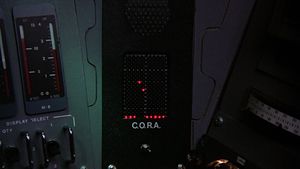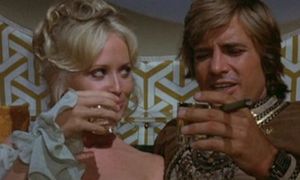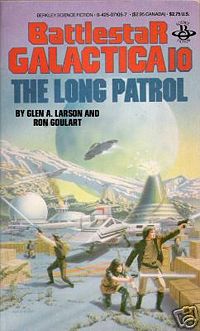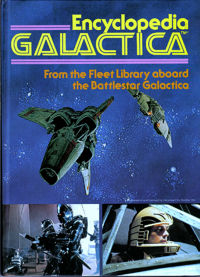|
|
|
|

|
This article has a separate continuity.
This article is in the Berkley books separate continuity, which is related to the Original Series. Be sure that your contributions to this article reflect the characters and events specific to this continuity only.
|
|
|
|
|
|
|
I usually enjoy novelizations more when the author takes liberties with the story and does not do a straightforward adaptation of the episode. This book is the one case where I wish the original story had been left alone. Ron Goulart makes a lot of changes to what was one of the better one-hour episodes of Battlestar Galactica, and virtually all of his changes are for the worse.
To Goulart's credit, he does write Starbuck better here than in the previous two novels. But his constant need to pair Starbuck up with a woman gets tiresome. Robber is now a gorgeous black-haired woman instead of a man. There are numerous extra scenes thrown in which aren't all that interesting. What is strange is that Starbuck drops his anger at Robber for stealing his ship pretty quickly. He believes her to be in danger even though he never is given a good reason, and so he goes off to rescue her (like the true hero he is!). There is a rather large plot hole in the fact that C.O.R.A. just happens to force Robber to land on a planet in the exact area where she has enemies. Of course, this is not the most believable of coincidences. A couple of other new characters are introduced, but none of them are interesting.
What comes across as a rip-off is when Goulart decides to rehash the "Fire In Space" episode by having kamikaze Cylon raiders attack Galactica at the end and people trapped inside a lounge (How original!). Three Cylon fighters ram Galactica, but the damage they do is pretty minimal compared to what happened in the episode when only one Cylon raider rams the ship.
We are given more space battles with the Cylons in the book than we did in the actual episode, but they are pretty dull as Goulart isn't very good at writing them. The Cylon kamikaze attack at the end is also fairly dull (and it shouldn't be). The Colonials beat the Cylons fairly easily each time they attack, so there is little suspense.
Perhaps the best thing about his book is the cover art, although there is a mistake as Starbuck is in a colonial uniform and Apollo is wearing a disguise. Of course, it should be vice-versa. Bottom line, if you miss this book, you're not missing much.
- This is the last of the Berkely novelizations. The remaining Berkely books would have original stories.
- When Athena walks in on Starbuck, she sees a second glass on the table. Starbuck tells her he took out a second glass because he had a feeling that someone would soon be joining him.
- In the midst of switching rooms, Starbuck trips on the carpet while looking around to see if Cassiopea is coming.
- When Adama says to keep tracking Starbuck because he may be on to something, Athena says to herself, "Probably a blonde."
- Croad lands his fighter next to the shuttle. Starbuck drops a crate on Croad's foot and then knocks him out and steals his fighter. He tracks down C.O.R.A., and the viper is empty. C.O.R.A forced Robber to land on a planet in the middle of territory where she has enemies. Starbuck goes after her and falls into a large pit. A woman named Candy approaches and pulls a gun on him. Then a man with a metal arm named Scrapper zaps her, knocking her into the pit with Starbuck. He helps Starbuck out and agrees to help him find Robber. They soon rescue Robber from a gang of thugs and then head back. Apollo and Boomer land and learn from C.O.R.A. what is going on. They head off to look for Starbuck. Not long after, Starbuck returns alone to scout the place out and Croad arrests him and takes him to Proteus.
- The Galactica does not alter its course.
- Imperious Leader, not Baltar, launches three Cylon raiders to investigate the signal.
- In the battle above Proteus, none of the Cylon raiders crash into the ambrosia, although Starbuck does black out.
- Two dozen people stay behind on Proteus.
- Imperious Leader launches three more Cylon raiders who attack the vipers and the shuttle on their way back to Galactica. The Cylons are easily destroyed, although Starbuck pushes his luck and almost rams into one.
- Athena and Cassiopea declare a truce and hang out with each other, wondering who Starbuck has hooked up with.
- Robber changes her name to Roberta.
- Starbuck, Roberta, and the other people from Croad go to Galactica's rec lounge when fifty Cylon raiders attack.
- Three Cylons raiders ram Galactica. The rec lounge loses air. Roberta passes out, but she managed to help several people and is declared a hero.
- Starbuck takes Roberta out to the Rising Star and meets the same waiter again. Athena and Cassiopea are in a booth next to where their reserved table is, so Starbuck has the waiter take them to another area.
Warning: Default sort key "Long Patrol (Book), The" overrides earlier default sort key "Long Patrol, The".
Encyclopedia Galactica: From the Fleet Library aboard the Battlestar Galactica (Windmill Books and E.P. Dutton 1979, ISBN 0525610391), edited by Bruce Kraus, is an encyclopedia of the Original Series.
Encyclopedia Galactica is presently out of print, although copies of it are intremittently available either through Amazon.com or eBay.
Due to its various inaccuracies, misspellings, and contradictory information, it is not considered a fully canonical source text for the Original Series. Battlestar Wiki does aim to note the difference between this text and aired information however, though makes no guarantees on its status in Battlestar canon.
A listing of errata in the book that deviates from already established canonical material, ordered by appearance.
- In general, the timeline given in the book does not correspond to the date Starbuck gives in "The Man with Nine Lives" (yahren 7322).[2]
- The book mentions that after serving with distinction in a dozen major engagements during the "Great War," he "returned to Carillon a hero," instead of Caprica.[3]
- The book mentions that Zac is short for "Zaccariah," although there is nothing to support this.[4]
- The book mentions that Adar was born in 6368, but contradicts this date by saying he became a staff assistant to the Quorum of Twelve in 5997, almost 400 years before he was even born.[5]
- The picture of the alleged Agro Ship is actually a picture of the Mining Ship seen in both the Original and Re-imagined Series.[6]
- The picture of the launch bay is referred to as a "ready-room" in the caption for the picture.[7]
- The picture of the landram from Saga of a Star World is referred to as a shuttlecraft.[7]
- The caption for a picture of a battlestar repeats the error of there only being twelve battlestars before the Battle of Cimtar.[7]
- The Borellian Nomen are referred to as "Borallians".[8]
- The laser bola are referred to as the "Laser-Bolt".[9]
- The top picture of a Boray is, in fact, the appearance of Count Iblis without special effects.[10]
- The Borays are said to be inhabitants of Equellus; they are inhabitants of Sectar. Equellus is the planet that Apollo crash-lands on in "The Lost Warrior".[10]
- According to Commander Cain's entry, he had Pegasus on "ready alert" which prevented his ship from being destroyed during the Battle of Cimtar. However, Cain was at Gamoray in an attempt to circumnavigate Cylon forces between Molecay and the Colonies at the time, and did not hear about the attack until well after it happened.[11]
- Carillon is said to have been discovered by human settlers nearly 200 yahren before the fall of the Colonies, but this is inaccurate as the planet was discovered by Baltar's agents; they later reported that the planet held nothing of value, and no humans went there to mine tylium (as claimed in the book).[12]
- The word Geminon is misspelled "Geinon".[13]
- The "dreadnought" depicted in the book is, in fact, a Cylon basestar over Carillon when Apollo and Starbuck ignite the tylium during the Battle of Carillon.[14]
- The term "drone" is defined as "compact, pilotless spacecraft" developed by humans. The term "drone" as defined in the series refers to robots, like Muffit II. Additionally, the small gallery of pictures depicting a drone are the Cylon Mines in the Straits of Madagon.[14]
- Count Iblis is called "Ibley".[15]
These are items that cannot fit in any other location, due to the lack of canonicy.
- Age of the Philosophers: an era of the Second Millennium, likely similar to the Renaissance period of Earth's history, when the Books of the Lords of Kobol were written.[16]
- antiscientific period: the period where the Colonials rejected technology after the exodus from Kobol.[17]
- Astralon: high-velocity particles, similar to meteoroids and micro-meteoroids, that are grouped together like a cloud. Armored battle craft are shielded from astralons, but they can cause damage to unshielded civilian vehicles, compromising the hull and ship's atmosphere. Smaller astralons are said to be undetectable by low-power scanners.[18]
- Bellerephon: battlestar on which Colonel Tigh served with distinction before his transfer to the Galactica in 6560. Tigh also served aboard the Atlantia during his rise through the ranks after being commissioned a Warrior on the field of battle for outstanding heroism during the Tauron campaign in 6525.[19]
- Books of the Lords of Kobol: semi-mystical books complimenting the Book of the Word, chronicling the events of the exodus from Kobol. They were composed during the Second Milennium's "Age of the Philosophers". The written style is described as "uneven and various," with "beautiful poems telling the loss and separation of the final days [... interspersed] with stark lists of individuals and their possessions". In comparison to the Book of the Word, the later Books contain "proverbs and parables" that have nebulous and varied meanings depending on the person reading the text. This so-called ambiguity "cannot be held to be a flaw," for it "reflects the greater uncertainty about the universe and the fate of humankind felt during the last days of Kobol".
After the establishment of the Colonies, the books became influential in creating the many religious sects, mainly because of Kobol's destruction due to science and technology. These sects created "elaborate mathematical interpretations of particular words, even particular sequences of symbols," believing that the fate of the entire universe was coded into the Books, and that it was the "mission of humankind" to decipher them. A majority of these sects died out by the Seventh Millennium.[20]
- Buzzer: While we know canonically that homemade buzzer can and has been made locally on one planet, the book says that "buzzer" is the general term for a variety of alcoholic beverages native to the "outer Colonial provinces," essentially a form of moonshine made of local plant life and "usually aged less than one yahren". Additionally, "excessive consumption" of this substance is a "serious medical and social problem in these lonely outposts, though no cure has been found".[11]
- Caprica City: a city on Caprica where Boomer was raised.[21]
- Colonial Code: the legal framework governing Colonial society, which was swiftly modified following the Cybernetic Revolt in 5160 to prohibit the integration of sophisticated artificial intelligence with mobile mechanical devices. This modification prevented humans from suffering the same grim fate that befell the first Cylons: destruction by their own creations. Rare exceptions to this code include the android daggit Muffey, built out of sympathy for the loss during the destruction of Caprica.[22]
- Cybernetic Revolt: an uprising that occurred in yahren 5160 during the Scientific Renaissance, which paralyzed the Colonial economy for over a yahren. The revolt shattered the dream of a "Golden Age" when all of society's boring, repetitive jobs could be done by intelligent machines, and led to swift modifications of the Colonial Code to prohibit the integration of sophisticated artificial intelligence with mobile mechanical devices.[23]
- Cygnus: an asteroid containing an outpost of the Picon colony, in addition to a tylium mine owned by Baltar's family. It was captured by the Cylons a century before the Battle of Cimtar and held for five yahren until the Colonials retook it. Baltar later turned Cygnus' tylium mine operation into the "largest intercolonial Tylium trading firm in the Galaxy".[24]
- Cylon Madness: a severe psychological condition that afflicted the survivors of the Final Destruction during the hopeless period following the Battle of Cimtar. This intense depression and despair threatened to overwhelm the human survivors until the social game of Triad was introduced aboard the Galactica. The game provided something for people to look forward to and helped save many from the psychological devastation. Cylon Madness represented one of the most significant mental health challenges faced by the Fleet in the aftermath of the near-extinction of humanity.[25]
- Dreadnought: Dreadnoughts are vast Cylon warships packed with weapons systems and landing troops, whose sole function is planetary destruction. They have no counterparts in the Colonial fleet. Dreadnoughts are neither highly maneuverable nor well-armed defensively. They are usually brought up from the rear after a sector's space defenses have been entirely subdued by previous attack. The defense of a Dreadnought in hostile space requires two Cylon Baseships.[26]
- Eagle Squadron: a legendary Viper squadron assigned to battlestar Prometheus. Prior to assuming command of Pegasus, Cain led this squadron, gaining "intercolonial fame" by doing so.[12]
- Era of Darkness: the time period that followed the settlement of the Twelve Colonies after the humans' exodus from Kobol. During this period, technology pertaining to interstellar travel and other higher-end electronic science were forgotten, for these were blamed for the fall of Kobol. As a result, each colony was cut off from the others, and the humans reverted to a "simpler, agricultural way of life". This is stated to have lasted for as long as two millennia.[13]
- Fifth Millennium: the time period when the Capricans led the colonies into the scientific renaissance, well after the Era of Darkness.[13]
- Final Destruction: a name of the final, decisive Cylon strike against the Twelve Colonies of Man.[27] The canonical name for it is the Battle of Cimtar.
- intercolonial: A term describing institutions, activities, trade, and travel that span or connect multiple colonies within the Twelve Colonies of Man. Examples include the Intercolonial Strategic Council (governing the war effort), the Intercolonial Kennel Association (recognizing daggit breeds across colonies), intercolonial travel and commerce, and various trading firms that operated across colonial boundaries.[28]
- Intercolonial Kennel Association: an organization that officially recognized different breeds of daggits across the Twelve Colonies. Each of the Colonies developed its own varieties of daggits over thousands of yahren, and by the time of the Final Destruction, over two thousand different breeds were officially recognized by this association.[29]
- Intercolonial Strategic Council: the body governing the Colonial war effort against the Cylons during the Thousand-Yahren War. Commander Cain dominated this council for years before his debacle at Molecay.[11]
- Interstellar Age: presumably the age that humanity rediscovered interstellar travel.[21]
- Long Peace: a 500-yahren period of "unparalleled prosperity" after the rediscovery of interstellar travel amongst the colonies; this occurred prior to the onset of the Thousand Yahren War.[30]
- nutron cased laser torpedo: a Cylon weapon included in the basestar's armament; upon detonating, it not only inflicts physical damage, but also emits rays that break down the cellular structure of both food and human tissue, likely similar to pluton poisoning.[7]
- Pan-Colonial Unification Party: a social and political movement that sought to unify the Colonies under one government politically, economically, and militarily; it was prominent on the colonies on Picon and Virgon. Adar worked to develop this party on Virgon, which ushered him into a role of president of this organization and later the presidency of the Quorum of Twelve.[31] Baltar also generously contributed to this party and was influencial (sic) in bringing the party to power on his own colony of Picon.[24]
- Pluton: A poisonous substance generated from fall-out of Nutron Elements which contaminates food.[32]
- Praesidium: the central governing body of the Colony of Caprica. During the Era of Darkness, it was an annual meeting of the Caprican buriticians (sic) where disputes were settled and taxes were set amid great festivities and revelry. As the Scientific Renaissance progressed, government by the elite was no longer tolerated. The Praesidium was progressively expanded until its members represented all segments of society. The privileges of the buriticians were gradually reduced until, by the time of the Great War, they had an automatic right to only three out of 300 seats. In time of war, however, the power of the buriticians was effectively enhanced. For the duration of such crisis, three-leader ruling councils wielded the power of the entire Praesidium. These were composed of a commoner, a military leader and a buritician. Since the buritician class also provided many military leaders, it effectively controlled the Colony in wartime. Because of the length of the Great Cylon War, this system was abandoned, and after 5770 the 300-member Praesidium was reinstated. The Caprican Praesidium ceded the vast reserve on which the Academy stood to the Quorum of the Twelve when cooperation was needed to develop a military force capable of repelling the Cylon attack.[33]
- preciptum layer: any mass of heavy-element matter in deep space, which can be the result of such natural processes as the gravitational decay of an asteroid, or may be the waste product of certain kinds of primitive space drive engines. They do not present a major hazard to navigation since (although light cannot pass through them) scanners can analyze them fully.[34]
- Prometheus: battlestar that Cain served on as leader of Eagle Squadron.[12]
- Scientific Renaissance: period in Colonial history dealing with the rediscovery and advancement of science.[30]
- Second Millennium: the second millennium of time, insinuated to be 2,000 years (or more) after the exodus from Kobol; a period during this time saw the creation of the Books of the Lords of Kobol.[16]
- Tauron Center for Science and the Arts: an educational institution that included a Physics Department where Dr. Ravashol worked as "the brooding genius" before designing and constructing his powerful communication device on the asteroid Arcta.[35]
- ultra-light drive: advanced propulsion technology that enables spacecraft to achieve velocities approaching the speed of light through manipulation of matter and energy at the subatomic level. The drives were first successfully developed and implemented in yahren 4980, marking the beginning of the Long Peace. They operate by converting solium fuel through controlled fusion processes that create directed energy streams, allowing vessels to manipulate space-time itself for near-instantaneous acceleration without crushing g-forces. The technology revolutionized intercolonial travel, reducing journey times from yahren to mere centons, and proved crucial during the Thousand-Yahren War for rapid redeployment of Colonial forces. Ultra-light drives are primarily installed aboard battlestars due to their immense power requirements.[36]
- University of Picon: an educational institution on Picon where Baltar studied "political economy".[24]
- Please note that page numbers reflect the numbering in the PDF file that is linked above, and not in the actual encyclopedia itself, as the pages are not individually numbered in the actual book.
- ↑ Due to the nature of Kraus' entry on page 7, it is unknown whether or not the name is a pseudonym.
- ↑ Kraus, Bruce (1979). Encyclopedia Galactica, p. 59.
- ↑ Ibid. 11.
- ↑ Ibid. 12, 57.
- ↑ Ibid., 12.
- ↑ Ibid. 13.
- ↑ 7.0 7.1 7.2 7.3 Ibid. 19.
- ↑ Ibid. 22-23.
- ↑ Ibid. 23.
- ↑ 10.0 10.1 Ibid., 23.
- ↑ 11.0 11.1 11.2 Ibid., 25.
- ↑ 12.0 12.1 12.2 Ibid., 26.
- ↑ 13.0 13.1 13.2 Ibid., 27.
- ↑ 14.0 14.1 Ibid. 34.
- ↑ Ibid. 39.
- ↑ 16.0 16.1 Ibid., 20.
- ↑ Ibid., 24.
- ↑ Ibid., 14.
- ↑ Ibid., 54.
- ↑ Ibid., 20-21.
- ↑ 21.0 21.1 Ibid., 20-21.
- ↑ Ibid., 49.
- ↑ Ibid., 49.
- ↑ 24.0 24.1 24.2 Ibid., 16.
- ↑ Ibid., 54.
- ↑ 'Ibid., 34.
- ↑ 'Ibid., 35.
- ↑ 'Ibid., 16, 25, 33, 40.
- ↑ Ibid., 33.
- ↑ 30.0 30.1 Ibid., 28.
- ↑ Ibid., 12.
- ↑ 'Ibid., 46.
- ↑ Ibid., 46.
- ↑ 'Ibid., 47.
- ↑ Ibid., 49.
- ↑ Ibid., 59.









